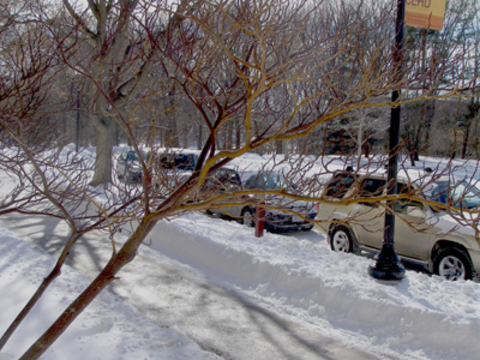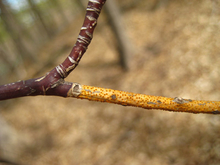Quick facts
- Golden canker is a common disease of pagoda dogwood.
- This disease can be found throughout most of the eastern half of the United States, including Minnesota.
- Infected branches turn bright yellow to orange in color and die.
- Golden canker can kill small twigs, large branches, and the main stem of pagoda dogwood.
- Golden canker doesn’t kill the roots of the tree.
- Prune out cankers. Remove and destroy the infected branches.
How to identify golden canker
- Cankers are present year round. They are most easily seen when trees are dormant and have dropped their leaves.
- Bark on infected branches turns bright yellow to tan in contrast to the purplish green healthy bark.
- Multiple small, orange, raised bumps develop on the surface of infected bark.
- Cankers are most frequently found at branch tips. They can progress downward to infect larger branches and main stems.
- Infected branches may not leaf out in spring.
- If the canker girdles the branch during the summer, leaves wilt and die. These dead leaves remain attached.
- The disease can be found on pagoda dogwoods grown in all types of sites: wet, moist, dry, shady and sunny.
Plants affected by golden canker
Golden canker is caused by the fungus Cryptodiaporthe corni. The fungus is only known to infect pagoda dogwood (Cornus alternifolia). The disease hasn’t been found on any other dogwood species commonly grown in Minnesota.
How does golden canker survive and spread?
- Cryptodiaporthe corni survives within infected branches and stems during the winter.
- The bright orange blisters found in the center of the branch cankers produce spore tendrils during rain or periods of high humidity.
- It is still unclear how the golden canker infects branches. It is likely that the fungus enters through wounds or natural openings like lenticels (raised pores) or leaf scars.
- The golden canker fungus can live within the branches of pagoda dogwood as an endophyte, a microorganism living within a plant without causing symptoms of disease.
- The fungus was present in 62.5% of apparently healthy stems collected from across Minnesota.
- It’s not clear why the fungus changes from a non harmful resident of healthy branches into a pathogen that can kill branches and stems.
How to manage golden canker
Prune off infected branches
- Make the pruning cut directly above a healthy bud that is at least 2 buds below the yellow discolored bark.
- Prune directly above a bud (within 1 cm), but don’t damage the bud in the pruning process.
- Avoid pruning the branch to the main stem if at all possible.
- Prune off infected branches when trees are dormant and temperatures are consistently below 32 F. This will reduce the amount of spores produced within the canopy in the growing season.
- Sterilize pruning shears between cuts with a solution of 10% household bleach or Lysol®.
- Infected branches should be removed from the site and burned or buried.
Reviewed in 2024




